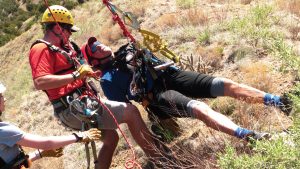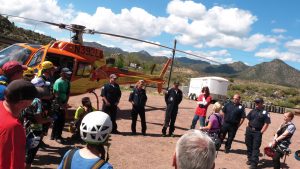“Lead guide to ground support! I have an unresponsive guest on platform H. Call the course manager, activate the EAP, contact EMS, and relay your ETA.”
“Copy that, ETA 7 minutes.”

Conducting drills with local first responders helps prepare for actual emergency situations. Preparing for these drills can teach you a lot, too—such as the amount of space needed for a rescue helicopter to land.
Your guide just activated your Emergency Action Plan, or EAP. You run, knowing that every second is important. You grab your manual and start calling out the steps you and your staff need to perform to get your injured participant the help he or she needs.
As operators, we often have all the steps written out in front of us to follow, but how do we know these steps are in fact the best plan of action for our course? Every year, emergency situations occur that courses weren’t prepared for. Nothing in our manuals or training can help because whatever happened was unforeseen and therefore wasn’t considered. Sometimes our only option in these situations is to improvise and make it look like we know what we’re doing.
During a debrief in the days or months after, companies may realize their EAP does not fit their course the way they thought, or that the EAP is seriously outdated. Unfortunately, flaws in preparedness are oftentimes only revealed when a serious situation occurs.
At Royal Gorge Zip Line Tours, we decided to take action, so we wouldn’t get caught in a situation we weren’t prepared for. To accomplish this, we went through three steps: reviewed our plans, developed relationships, and conducted drills. This process ensures that not only our staff, but also our first responders, are prepared for emergency situations in an efficient manner.
Step One: Review
For starters, review your Emergency Action Plan, along with your injury reports. Understand the process you already have in place and compare it to your records of reoccurring injuries. This will give you a feel for “what is happening.” It can also spark ideas for “what could happen.”
Next, compile different scenarios for your guides/facilitators to work through. This will spur their thought processes and get them thinking outside the box, even as they follow their training. Include scenarios that involve guests with different disabilities that you may encounter in normal operations. It’s easy to practice scenarios with trained professionals, but remember: the people you take through your course are not professionals.
Step Two: Develop Relationships
When planning drills that include first responders, it is vital to take into consideration what kind of property your course is located on. There are many more people who need to be involved if you are located on public land compared to private land. Take time to investigate and ensure you are communicating with all the right people. Do you need permission to run drills? Are there certain restrictions within your jurisdiction? These are all things you can find out with a little asking around, if you don’t know already.

When developing or revising your Emergency Action Plan, account for the location, terrain, and nature of the elements of your park or course. Whether you are able to conduct drills or not, meeting with local emergency first responders helps get everyone on the same page in the event of a real emergency.
To establish a working relationship with your local first responders, set up an in-person meeting with each agency you might call on. Bring the questions and concerns you as a manager or owner may have, such as how long they think it will take to get to your location in the event of an emergency.
Find out what specific things they would need your company to provide to ensure a fluid rescue. For example, our Flight for Life agency needs an open area about 100 feet x 100 feet, and no more than 10 percent grade, to land the helicopter. However, they can land in a smaller area if absolutely necessary. Also, one of our courses sits in a different jurisdiction than our city fire department, so if something were to happen, we would possibly need to activate two different fire departments.
After talking with each agency, set up two dates: one to plan the drill, the second for the drill itself.
The planning meeting will bring all the agencies together to not only discuss the drill, but to show the first responders your course, access roads, and other important aspects of your location. This will help first responders prepare and understand the logistics.

In some cases, rescue vehicles aren’t able to access certain areas of a course or park. If so, you will need alternative transportation for first responders, and for moving the injured person or persons safely to the emergency vehicle(s).
This first meeting can lead to important discoveries. For instance, at our high mountain desert location, we never knew that we needed to activate Flight for Life for a rattlesnake bite. We also learned that our access roads are too narrow to get an ambulance onto our course. We would have to drive the ambulance crew to the location of the incident and drive them back out in our 4WD Ford Ranger.
Step Three: Conduct a Drill
When setting up the drill it is important to be specific, because miscommunication can detour the end results. Be specific about the start time, the location, and the drill scenario.
1. Prepare. On the day of the drill, have your team ready. We designate a rescue guide, ground support, medical flagger, and a victim. Each understands his or her role and responsibilities.
2. Record. When the time comes to activate the drill, start a timer, because having a relative timeline will aid in preparing for a real emergency. Take note of all the things that go smoothly, as well as what needs to be improved.

After the drill is complete, gather everyone for an in-depth debrief.
3. Debrief. After the drill is complete, gather everyone for an in-depth debrief. Get input from each agency and also from your guides. Take everything said during the debrief into consideration.
Some aerial adventure operations may not be able to conduct a drill. Do not let this deter you from refining your EAP. It’s especially important to invite your first responders to your site, and give them a chance to learn about your course. Let them participate in the activities, see your access routes, and read through your plan. Sit down like you would in preparation for a drill, and discuss the needs of the responders as well as the needs of your company.
This could take some piecing together if you are not able to get all the first responders to your location on the same day.
Make Revisions
When you have sufficient information, revise and update your EAP. Be clear and concise about what you write for each person’s role. If roles are different on the ground compared to at height on course elements, describe those roles as well. If you have any questions during this process, source the knowledge of your Professional Vender Member (PVM) and other people you may know in the industry. Let others, including your staff, look over your revisions and add their input.
Each EAP is specific to the site; make sure the Emergency Action Plan at your location is compatible with your operation. Some sections of an EAP that I suggest including are:
• element/platform rescues
• ground (trail) rescues
• hazardous weather evacuations
• fire evacuation
• active shooter procedures
• first responder needs
• important addresses and phone numbers
• course maps
• an appendix with all emergency documentation and reporting procedures.
Consider adding a section on reoccurring injuries and how to mitigate them. If your staff is trained in first aid, include a reminder on how to properly provide the first aid required for those injuries.
When dealing with any emergency on course, everyone involved should be following a coordinated plan. Creating a relationship with local first responders ensures not only that everyone is on the same page, but that they are reading the same book.
Some of these steps take time to implement. You may encounter scheduling difficulties. However, the time spent training, improving, and building relationships with local responders is time well spent—and time saved later.



